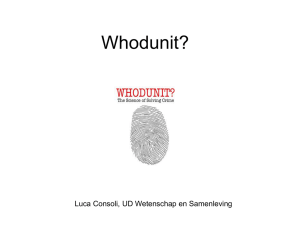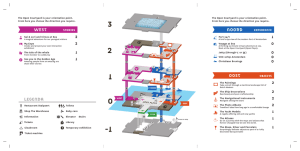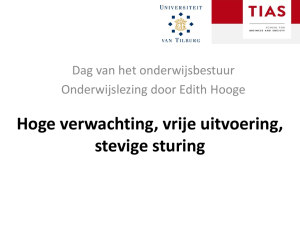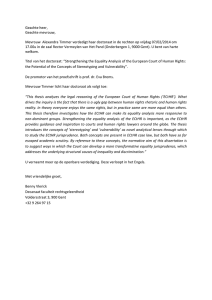Dear Friends, - Graaff Reinet Museum Graaff Reinet
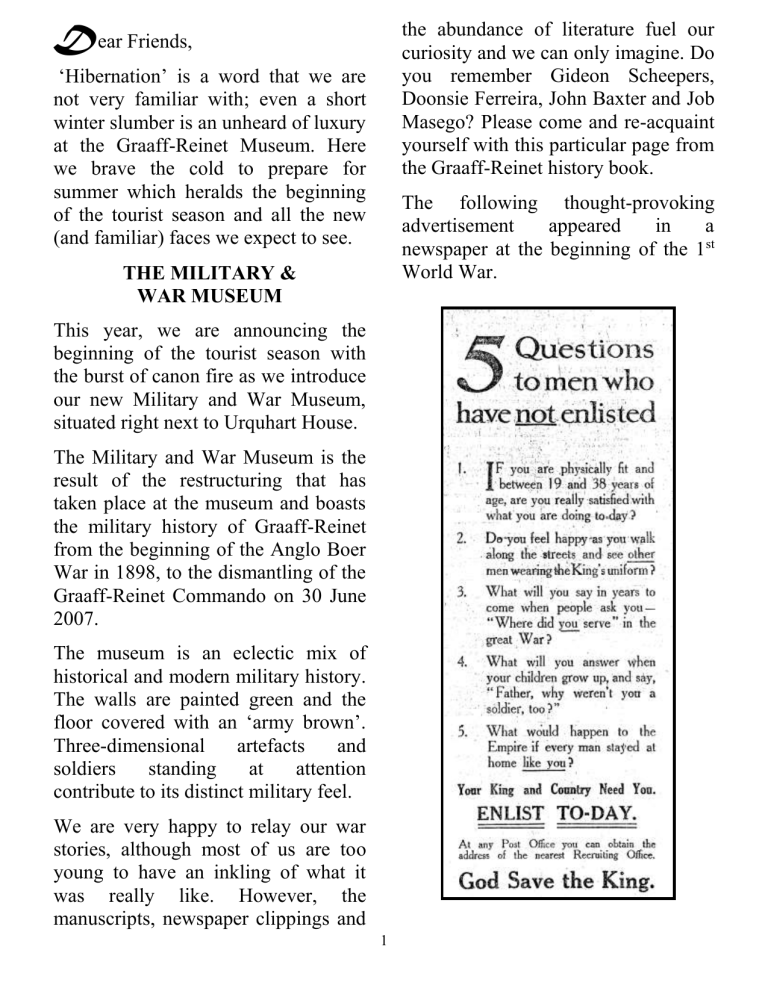
D ear Friends,
‘Hibernation’ is a word that we are not very familiar with; even a short winter slumber is an unheard of luxury at the Graaff-Reinet Museum. Here we brave the cold to prepare for summer which heralds the beginning of the tourist season and all the new
(and familiar) faces we expect to see.
THE MILITARY &
WAR MUSEUM
This year, we are announcing the beginning of the tourist season with the burst of canon fire as we introduce our new Military and War Museum, situated right next to Urquhart House.
The Military and War Museum is the result of the restructuring that has taken place at the museum and boasts the military history of Graaff-Reinet from the beginning of the Anglo Boer
War in 1898, to the dismantling of the
Graaff-Reinet Commando on 30 June
2007.
The museum is an eclectic mix of historical and modern military history.
The walls are painted green and the floor covered with an ‘army brown’.
Three-dimensional artefacts and soldiers standing at attention contribute to its distinct military feel.
We are very happy to relay our war stories, although most of us are too young to have an inkling of what it was really like. However, the manuscripts, newspaper clippings and
1 the abundance of literature fuel our curiosity and we can only imagine. Do you remember Gideon Scheepers,
Doonsie Ferreira, John Baxter and Job
Masego? Please come and re-acquaint yourself with this particular page from the Graaff-Reinet history book.
The following thought-provoking advertisement appeared in a newspaper at the beginning of the 1 st
World War.
FOOD FOR THOUGHT
By HERMI BAARTMAN
From the memoirs of MAURICE
PALMER, as recorded by his sister,
Iris Knight
Maurice Palmer volunteered for active duty in 1940 and sailed for North
Africa in the Mauretania on 21 June
1941. After intensive training and fierce battles on the frontier in Egypt and Libya, he became a prisoner of war at the Battle of Tobruk on 21 June
1942, exactly a year after departure from Durban. He was captured by
Italians of the Axis Forces and so joined his comrades in Bengazi in a cemetery, which served as a makeshift POW camp. He suffered tremendously and had many adventures but as usual, I was captivated by his account of the culinary adventures and initiative to stay alive and build their strength.
“We then moved to a camp which was on higher ground overlooking
Derna where we stayed for some weeks. During this time we met
Mussolini who came to inspect the camp. First a ten ton truck load of bread arrived where it was deposited inside the gate of the camp. Then Mussolini arrived in a car accompanied by many photographers, the gates were thrown open and prisoners were called and ordered to stand around loaves of bread. Mussolini strutted
2 up and down while movie cameras whirled away. He asked me where
I came from and when I said South
Africa, he said, “Oh, a very fine country and we shall soon be there.
” Then Mussolini returned to his car and moved off and the 10 ton truck moved in and took away all the bread. “
The POW’s had as rations, one small loaf of bread and one tin of bully beef, between two men per day.
As POW Maurice was shipped to
Italy and from there to Germany.
After 2 years of hunger and depravation, the tide turned and towards the end of 1944, Maurice remembers:
“All ranks up to Corporal had to go out to work and they were sent to
Breslau, a large educational centre, as working parties. So off we went and we were housed in farm buildings on the outskirts of
Breslau. Every morning we were marched to the train terminus and taken into the centre of the town and put out work sorting parcels in the post office.
Breslay was a railway junction and therefore a clearing house and the
Prisoners of War had to sort parcels taken from the rail trucks.
Lots of parcels went through
Breslau to the Russian front, sent to the German soldiers there from
their families. Many of these contained delicious food and delicacies. We would open the parcels surreptitiously and we lived well off them. The soldiers on the
Russian front in turn, sent vodka to their families in Germany.
This proved our undoing as some of the POW’s drank the vodka and on the first night two of them passed out. Pals carried them back to camp. This continued until the ruse was rumbled. So we all lost the job at the post office and we were sent away to barracks outside of Breslau to make air raid shelters.
One night in January 1945 we heard guns firing and we noticed that the Germans were very agitated as the Russians were making a push. The Germans told us to be prepared to march west away from the on-coming
Russians. We could only take what we could carry, so we made sleighs of bunk slats and packed stuff on the sleighs. On January
25 th , 1945, we set out, 2 men to a sleigh (I was with Harold Bates).
We marched for 4 days over frozen roads and at night we would sleep in barns on the roads. There were 2,000 of us.
Suddenly the thaw set in and the sleighs became useless and so most of them were discarded.
Harold Bates and I hung on to ours and took it through a village.
Whilst in a village, a woman was standing, looking on and she had a pram. I offered her a slab of chocolate for the pram which she accepted. So we transferred the goods from the sleigh to the pram and we pushed it for 40 days.
After 500 miles we entered the gates of another POW camp at
Ziegenheim. As we went through the gates, the pram collapsed!!!!!!!!!!
Another time our guards had a little wagon pulled by 2 horses, piled with goods on it. The horses got into bad condition and the guards decided to shoot the horses. We asked for them and stopped for a rest as we were permitted a rest day every 6 days. We borrowed a mincing machine and we skinned the horses and stewed them.
Apart from these horses we lived off the land, taking turnips and potatoes when we could find them .”
THE LAUBSCHER DENTISTRY
COLLECTION
The name Laubscher represents good strong teeth and healthy gums. For many years, Dr Jack Laubsher was the end of many a toothache.
Dr Jack Laubscher was born in
Graaff-Reinet on 5 July 1918, as the son of parents who were both
3
qualified dentists. They started their practice in Graaff-Reinet in 1915, making his mother the first female dentist of the Union of South Africa.
Dr Jack followed in father’s footsteps and like his parents and his uncle
Alex, went to study dentistry at the
University of Edinburg in Scotland.
He was a brilliant scholar and won prizes for chemistry, physics, anatomy, physiology including the best student award.
He married Dorothy van der Merwe from the farm Skietkuil in the
Murraysburg district, on 23 December
1950. They had five children and Jack, the youngest, became the third general dentist in Graaff-Reinet.
Dr Jack Laubscher was mayor of
Graaff-Reinet for two terms: from
1956 to 1958 at the age of 38 years and then from 1961 to 1963. He had a vast knowledge of civic affairs and put that to good use.
He had a pilot’s licence and loved to fly Tiger Moths, Fairchilds and Piper
Cherokees. During World War II he converted a car to run on petrol distilled from charcoal. Once he even built his own automobile. Die Burger reported: ‘Tandarts se maankaart tuis in die Karoo”, but the Government of the day accused him of being a car manufacturer and he had to dismantle the car.
Dr Jack Laubscher passed away on 13
September 2005.
4
The Laubscher collection, consisting of dental equipment, furniture, medical instruments, chemicals and a very interesting variety of dentures, is currently on exhibition at Reinet
House.
DIE HARRIET RABONE
SITKAMER
Die Ou Residensie spog vanjaar met die nuwe Harriet Rabone sitkamer, sterk geaksentueer in boergonje-rooi en room.
Dogtertjie in blou,
‘n skildery deur
Alfred Palmer en geskenk deur Me.
Pam Barkley, is die fokuspunt van die kamer en ‘n baie belangrike toevoeging tot die museum- versameling. ‘n Skildery van Palmer is ook in die San Francisco Museum in die VSA te siene.
William en Harriet Rabone het destyds die Residensie van William
Thomas Brown gehuur. William
Thomas Brown het toe al reeds die huis in 1831 van Jacobus Gerber gekoop.
Harriet het haar eerste brief vanuit
Graaff-Reinet uit die Residensie geskryf. Die volgende is uittreksel uit twee briewe wat in Julie 1854 en
Augustus 1854 geskryf is:
My dear Agnes,
I presume you know all about the house (The Residency) , so I will at once open the door of our room which
you know is a lofty, very large parlour, and the windows, being tremendously high, would make a first rate studio for Lizzie. I have put little white curtains up, but above these may be seen the foliage of the lemon trees. A large oleander which had gladdened me all summer with its bright rose-coloured blossoms. The floor requires no carpet, being of dark wood which is oiled.
My dear Agnes,
I wish you could see our snuggery.
Fancy a little corner house, with thatched roof, stoep all around, shaded by syringas (Pride of India)
(perhaps lilacs ), 2 small parlours – one a dining room, the other a drawing room – both with long window curtains, and flowerpots on the window sills containing a few choice plants and seeds (among the latter some sensitive plants), sofa, books, papier maché work table (very pretty – William bought it for his lazy wife) – little work basket, which has a very easy life of it you may be sure! – a few Art Journal prints hung on the walls, a very handsome set of chimney vases on the mantle-piece (these were given to me by the wife of the gentlemen whose portrait I have just finished) (this gentleman turned out to be Mr Wimble)
– and your vivid imagination can form some notion of our home, or at least the part of it in which we receive visitors.
Harriet het elke dag, of wanneer sy ‘n tydjie kon afknyp, haar gedagtes en ondervindinge op papier gesit. Die briewe wat uiteindelik haar ‘liewe
Agnes’ bereik het was dus baie volledig en beskrywend. Hierdie briewe sou later deur Arthur Rabone as deel van die boek The Records of a
Pioneer family , gepubliseer word.
BAIE GELUK
JESSIE & JESMOND DE GAMA
Op ‘n wonderlike lentedag in
September, het Me Jessie Gouws Mev
Jessie De Gama geword. Die bruid het asems weggeslaan in ‘n wit trourok, kwistig geborduur met silver draad.
Die sterk en aantreklike bruidegom was duidelik baie trots en het gestraal van geluk.
Jessie en Jesmond, ons wens julle voorspoed en sewe leë sakke sout toe!
Mag julle slegs geluk en liefde tot in lengte van dae ervaar.
FRIENDS OF THE MUSEUM
REPRESENTATIVES
At the Annual General Meeting held in June, Mrs Elizabeth van Wijk and
Mr Jacob Daniels were elected as the two representatives of the Friends of the Museums Association. These two members are also serving on the
Board of Trustees and will be especially concerned with developing the Association and to act as a link between the Association, the Board and the Head of the Museum.
5
HALDANE MURRAY by HERMI BAARTMAN
Mrs Bardier has donated a framed portrait and brass plaque of
Haldane Murray. These artifacts came from a hall built in Murray
Street in honour of Haldane after his death in German East Africa. This set me on a path of discovery, first on the life and times of Haldane but also on all the South Africans who participated in this Great War.
Time and tide waits for no man, thus time is hurtling on towards the commemoration of the 1 st World War
100 years ago.
Haldane Murray’s life ended during this war, somewhere in Africa. He was the second son of Andrew
Murray, the great Psalm writer and author of more than a hundred religious books, and he was Mrs Prue
Hobson’s grandfather.
He was educated at the Boys’ school in Wellington, took his B A at the S A
College and went to Cambridge to read ethics and philosophy. Here his horizons broadened beyond the narrow Calvinistic tenets of his forbearers. He realized that the ministry was not for him and turned to teaching. Very soon he was promoted to headmaster and at 26 he was appointed as school inspector.
He married Minnie Parkes and entered politics for a while. Haldane bought
6 the family farm Broederstroom, but it was his wife who turned out to be the champion farmer whereas Haldane was more involved in cultural and community affairs.
During the 1914 Rebellion he joined the Graaff-Reinet Commando under
Commandant Pieter Pohl. This commando was part of the SA forces which invaded German West Africa, under the command of General Louis
Botha. The campaign lasted 5 months.
The Graaff-Reinet Commando rested for a while until a call came for the
East African Campaign.
Gen Louis Botha begged Haldane not to sign up for active duty, but the bond with his comrades was too strong. He declined a seat on the commission to investigate the Poor White question, and was also serving on the Reserve
Bank Board. Alas, he signed up, never to return!
He fell in action on 16 September
1916, when he ran into a hail of bullets to carry Bonny Rose, whose shoulder was shattered by a bullet from a machine gun, out of harm’s way. He was buried at the foot of a great baobab tree in Tanzania.
This campaign in the wilds of Africa was no picnic. Logistics were poorly managed and the soldiers were left to forage for food in a wilderness where grass grew 6 feet high, rode through
14 feet high sorghum plantations and tropical rain. They fought through a
wild and trackless country with dense scrub, treacherous marshland, impenetrable jungle, vast primeval forests, unabridged rivers, grassy steppes and sandy deserts.
They saw the tremendous bulk of the extinct volcano, Kilimanjaro, heaving its mighty peak nineteen thousand, three hundred and twenty-one feet into the clouds, glaciers on its icy peaks swelling great rivers in the tropics!
While poisonous snakes invaded the undergrowth; they came across rhinoceros, antelope and giraffe, while crocodiles tore limbs off soldiers crossing rivers, giant butterflies and dragonflies flitted around.
However, more dangerous were the malaria mosquito, the tsetse flies and the hateful jigger fly which burrowed its way under toenails and had to be cut out painfully. Pestilential parasites brought on sickness and death for thousands of soldiers, horses and mules.
The enemy was the most dangerous; well-trained Askaries (African Massai people trained by the Colonial
German occupiers of Tanzania, called
German East Africa).
The Allied participants sounded more like the United nations; men from the
Gold Coast, Nigeria, West Indies, troops from India, Royal Fusiliers
South Africans, Rhodesians, Boer
Settlers, East African Arabs, men from Uganda and local soldiers from the King’s East Africa Rifles.
In accounts of the campaign, written by Haldane Murray and published in the Graaff-Reinet Advertiser, food is frequently mentioned. The saying goes: An army fights on its stomach but these soldiers ate sugar cane until their mouths bled, “pap”, roasted arrowroot, and all kinds of strange grub. Haldane wrote: This morning some men dynamited the river and we had some fish. At some stage rations reached them and biltong and drinking chocolate were added to their meager rations.
Haldane Murray was deeply missed and mourned by the entire community and all his comrades. He was honoured in many ways.
Thank you to Mrs Prue Hobson for additional information.
NOTHING NEW UNDER
THE SUN by Hermi Baartman
I undertook the pleasant and extremely interesting task to organize, catalogue and computerize the documents and annals of the Die Middellandse
Regiment. A more comprehensive source of the history of a 2 nd World
War Regiment would be hard to find.
It would be easy for an author to base a book on all the documents, memoirs and publications in the collection.
7
Recently I read an article in a newspaper about a school in Port
Elizabeth which disappeared lock, stock and barrel, carried away over a period of a week or two, leaving just the cement foundations of the entire complex as evidence that there once upon a time existed a building.
On reading the following newspaper article, I realised once again that there is nothing new under the sun.
SUNDAY TIMES
JOHANNESBURG TRANSVAAL
13 MAY 1945
Flight Lieutenant Rex Reynolds –
A prisoner of war for three and a half years, seven getaways from camps only to be recaptured.... then freedom for Rex Reynolds of the editorial staff of the Sunday
Times.
“I got away from an Italian camp and passed off for some time as a
German war correspondent on leave. When I met Germans, I posed as an Italian. One day I ran into Germans and Italians and I had my first taste of solitary confinement.
We had radio sets and we got the
BBC news. I sometimes wonder how we would have fared without the hope of that news. I know now that most of us would have died but for the Red Cross parcels.
8
Yes, men died in the camps, but they were nearly all Russians,
Poles, Czechs and Frenchman.
They died through slow starvation.
We all lost weight. Food was bad in many places. We ate mangolds
(sugar beets) and they were stringy and frosty. During my periods of freedom, I used to think that a raw turnip was good eating.
Humour? Yes, there were times for laughter and laughter is a tonic which you can’t live without in a
POW camp. The British Tommies were the humorists. The Germans could manage all the other prisoners, but there was something about the Tommies which baffled them. They were always brewing tea and making fires. They wouldn’t do without fires.
Joints were ripped from wooden buildings until the buildings collapsed. Huts disappeared overnight for firewood. Beds made firewood. I was once in a hut with four beds and was told not to burn the beds. I used two for firewood.
A contractor brought in a load of wood for building. That night it disappeared; the next day another load went. He and his workmen had to guard the third load all night.
The best firewood joke was played on a sentry. He had a beat about
50 yards; one night when he was
at the other end of his beat his sentry box disappeared. In a few minutes not a trace of it was left! “
ONS VERGETE HELDE
Graaff-Reinet se bruin en swart rugbyspelers
My huis het ‘n slagveld geword waar die stryd om die Rugby
Wêreldbeker obsessief gemonitor word. Spelpatrone, vleuels, hakers en onkantspel word tot in die kleinste besonderhede bespreek.
Die televisie behoort aan Pa en Pa alleen.
Die boek “Forgotten Heroes’ het onlangs sy opwagting in ons huis gemaak en vertel die geskiedenis van rugby onder swart en bruin
Suid-Afrikaners. Die opvatting dat rugby ‘n eksklusiewe sport is word hiermee finaal ‘n nekslag toegedien.
Die lewe van die mense van die
Karoo het rondom kerk en sport gedraai. Die meeste het hul tyd met tennis verwyl, maar die koms van die winter het ‘n behoefte na ‘n wintersport gelaat. Rugby het dié behoefte bevredig.
Graaff-Reinet het gl ad nie ‘n tekort aan talent gehad nie. Rugby was in almal se bloed. Baie van die ouer garde onthou nog Leslie
Martin se raakvat en die jonge
Fanie Welman.
9
Rugby was ook nie rugby sonder die Koeberg-begeesterdheid nie.
Die Polytechnics rugbyklub is in
1926 gestig. In die oue dae moes die span met ‘n ossewa na omliggende dorpe soos
Steytlerville, Klipheuwel,
Willowmore, Cradock en King
William’s Town reis. Die reis het douvoordag begin en die terugkeer was somtyds na middernag. In
1937 het Eli January die sekretaris van die klub geword. Nie net was hy sekretaris nie maar ook lyntrekker, sport-organiseerder, bagasiedraer, fondsinsamelaar, werwer van spelers, paaloprigter, dokter en fisioterapeut. Mense het later na hom as Mr Polytechnics verwys.
Teen die 193
0’s het rugbykoors die Graaff-Reinetters beetgepak en ‘n tweede klub die Swallows
RFC, het ontstaan. Een van die reëls van die klub was dat lede mekaar entoesiasties met ‘n bulderende ‘Swallows’ moes groet ongeag waar hulle mekaar raakgeloop het. (Dink net watter chaos dit in ‘n kerk kon veroorsaak).
Reeds van die begin was daar wrywing tussen die twee klubs. Dit was voor die tyd van die
Groepsgebiedewet en baie
Polytechnic spelers het in die dorp gebly. Ceasar Koeberg, stigterlid van Swallows, het ook in die dorp
gewoon. Lank voor die aanvang van die eerste wedstryd tussen die twee spanne, het Polytechnics verklaar dat Koeberg verplig was om vir hulle te speel aangesien hy in die dorp gebly het. Hierdie aangeleentheid is enkele dae voor die eerste wedstryd opgelos.
Swallows het ook ‘n klousule in hul beleid gehad wat onderwysers verbied het om amptelike poste binne die klub te beklee. Die gevoel was dat die meeste spelers van die werkersklas was en dat die klub deur hulle bestuur moes word.
Alhoewel die klubs in Graaff-
Reinet ook deur binne-politiek gekenmerk is, het spelers tog kans gekry om hul liefde vir rugby uit te leef en het ‘n paar merkwaardige spelers na vore getree:
Leslie Martin, ‘n jong onderwyser gebore in Oos-Londen, het sy eerste provinsiale wedstryde vir
Grens in 1946 gespeel. Nadat hy vir ‘n tyd lank die Wes-Kaap in die
Westelike Provinsie Liga verteenwoordig het, keer hy terug na die Karoo as jong onderwyser by ‘n plaaslike skool. Lesley Martin was ‘n speler van onskatbare waarde omdat hy rugby in verskeie provinsies gespeel het. Sy kennis en ervaring sou ‘n groot invloed op rugby in die Karoo hê.
Isaac Säfers , gebore in Aberdeen in 1941, het rugby as leerling by
10
Spandau Sekond êre Skool begin speel. Op aandrang van Fred
Hufkie, destyds skoolhoof en
SARU amptenaar, moes Isaac op
‘n dag inspring toe dit blyk dat die skoolspan ‘n man kort. Watter held was hy nie daardie dag nie! Op die jonge ouderdom van 17 is hy as senter gekies om Sentraal Karoo te verteenwoordig. Tussen ‘62 en
‘63 het hy ook die Suid Westelike
Distrikte verteenwoordig. Hy sou later SARU Springbok-kleure verwerf. Vir baie was hy die beste senter wat daar ooit was.
Kosie Welman het reeds in 1967 as jong student die Bellville
Rugbyvoetbalunie gereeld verteenwoordig. Vanaf 1971 tot
1973 het hy vir Sentraal Karoo uitgedraf en is selfs in 1971 opgeneem in die Suid-Afrikaanse
Rugby Federasie Toetsspan na
Engeland. Weens politieke oorweginge het hy hom egter van die span onttrek. In die laat sewentigerjare het hy verskeie kere as skeidsregter vir SARU opgetree en in die vroeë tagtigerjare was hy president van
Sentraal Karoo. Welman het in
2000 erkenning vir sy bydrae ontvang en ‘n Springbok - kleurbaadjie is aan hom toegeken.
Fanie Welman het as jong speler vir Spandau Sekondêre Skool en later as 18 jarige, senior rugby vir die Suid-Kaapse Opleidingskollege
gespeel. In 1972 het hy vir
Sentraal Karoo begin speel. Sy mees teleurstellende wedstryd was teen KWARU toe ‘n strafskop aan
Sentraal Karoo voor die pale toegeken is en Themba Ludwaba die skop verhoed het deur op die bal te gaan sit.
Piet en Danie Koeberg . In 1978 is
Piet tot die SARU Uitnodigings span verkies wat in Kaapstad moes gaan speel. Hy onthou dit nog steeds as die hoogtepunt van sy rugbyloopbaan. Hy het ook
Sentraal Karoo vanaf 1969 tot
1983 verteenwoordig.
Die museum sou graag hierdie interessante inligting wou versamel en uitstal. Die Graaff-Reinet
Rugbyklub het ook hierdie jaar sy honderdjarige bestaan gevier. In ons argiewe het ek ‘n pragtige foto van die spelers gekry wat rondom
1926 dateer. Indien enige van u belangstel om navorsing hieroor te doen, daar is ‘n skatkis vol inligting en ingeligtes wat wag om ontgin te word.
BRIAN VAN WIJK
Our deepest sympathy goes to Liz van Wijk and her family who have lost a husband and father.
ANNUAL STREET STALL
Our annual street stall will once again be held in front of Spar on the 26 th of October.
11
Mrs Marie Biggs and her team will be knocking on your doors requesting jams and preserves, cakes and biscuits, plants, homegrown vegetables or, if you please, a financial contribution.
Your support would be very much appreciated.
Please bear in mind that the
Annual Street Stall is one of two events organized by and for the
Friends of The Museum, the other of course being the Annual
General Meeting. We would like to make a success of this single event and look forward to seeing you there.
OUTSTANDING
MEMBERSHIP FEES
I have to remind all who have not paid their annual subscription fees to do so as soon as possible.
Many members have not been paying their fees and unfortunately the museum cannot afford to print and distribute newsletters and annual reports to people who have not renewed their membership.
Please let us know if you have decided to terminate your membership. However, I would like to implore you to remain a Friend of the Museum as it promises to be a very rewarding partnership.
NEW FACES AT THE MUSEUM
I am very glad to announce the appointment of Miss Vuyokazi Pika as our new Collections Manager.
You may recall that Miss Pika was appointed as intern in October
2006 and just after her contract expired she became a permanent member of our team. Apart from tour guiding and manning one of our five museums, Miss Pika will be responsible for new acquisitions, updating archival records and issuing collections to put on exhibition.
Mrs Amanda Jacobs holds a
Bachelors degree in Anthropology and is our new Education Officer.
She will have the privilege of taking school groups around and to align her programs with the school curriculum.
A big welcome also to Miss
Katriena Booysen, Miss
Thomokazi Fihla and Mr James van Rhyners. Miss Booysen has been a Board of Trustee employee for the past three years and Mr
Van Rhyners for nine years. Miss
Booysen and Miss Fihla, who hails from King William’s Town, were appointed as general assistants and Mr Van Rhyners as gardener.
Dear Friends, the Graaff-Reinet
Museum has experienced tremendous growth. Not only did we open the doors of a new
12 museum but we welcomed five new staff members.
We would like to invite you to join us in all the new and exciting ventures we envisage for the future. Thank you for your continuous and loyal support.
It seems as if it was years ago when I started writing my first newsletter, when in actual fact it was just about six months ago.
How time flies!
More than two months remain of the year to fulfill your resolutions for 2007. We wish you well in all your endeavors.
Kind regards
Anziske Kayster & Staff
EDITORIAL STAFF
Articles & Research:
Anziske Kayster
Hermi Baartman
Editing:
Elizabeth van Wijk
Jessie De Gama
Production & Distribution:
Denise van Wyk
James van Rhyners
13

